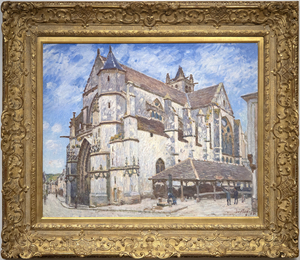N.C. WYETH (1882-1945)










Provenance
MetLife, Inc. Corporate Collection (Commissioned for New York offices)Heather James Fine Art, New York
Exhibition
New York, NY, 1985, no. 13, "Coming of the Mayflower"Literature
"The Days of the Pilgrims Live Again in Our Murals," The Home Office (publication of Metropolitan Life Insurance Co.), vol. 23. no. 7 (Dec. 1941)N. C. Wyeth, Income Tax Notes for 1941 (unpublished, Brandywine River Museum Library)
Douglas Allen and Douglas Allen, Jr., N. C. Wyeth, The Collected Paintings, Illustrations and Murals (New York: Crown Publishers, 1972),...More... ps. 169-172, illus. b/w p. 169
Robert San Souci, N. C. Wyeth's Pilgrims (San Francisco, CA: Chronicle Books, 1991), detail illus. On frontispiece
Christine B. Podmaniczky, N. C. Wyeth, A Catalogue Raisonné of Paintings (London: Scala, 2008), M.67, p. 629
...LESS...
About The Coming of the Mayflower in 1620
N.C. Wyeth’s extraordinary skills as an illustrator were borne of impeccable draftsmanship and as a painter, his warmly rich, harmonious sense of color, and ability to capture the quality of light itself. But it is his unmatched artistry in vivifying story and character with a powerful sense of mood that we admire most of all — the ability to transport himself to the world and time of his creation and to convey it with a beguiling sense of conviction. That ability is as apparent in the compositional complexities of Treasure Island’s “One More Step, Mr. Hands!” as it is here, in the summary account of a square-rigged, seventeenth-century merchant ship tossed upon the seas. The Coming of the Mayflower in 1620 is a simple statement of observable facts, yet Wyeth’s impeccable genius as an illustrator imbues it with the bracing salt air and taste that captures the adventuresome spirit of the men and women who are largely credited with the founding of America. That spirit is carried on the wind and tautly billowed sails, the jaunty heeling of the ship at the nose of a stiff gale, the thrusting, streamed-limned clouds, and the gulls jauntily arranged to celebrate an arrival as they are the feathered angels of providence guiding it to safe harbor.
The Coming of the Mayflower in 1620 was based on two studies, a composition drawing in graphite and a small presentation painting. The finished mural appears to have been installed in 1941.
History
Before there was television and of a time when film was still in its infancy, N. C. Wyeth’s illustrations electrified the stories he visually shaped and annotated. As a young reader of “Treasure Island,” who can deny the urgency to read on to the next glossy illustration? Or, in excited anticipation, thumb through the pages repeatedly to the pictures ahead, so alive and vivid and full of bravado?
In 1939, The Metropolitan Life Company offered Wyeth a commission of a different sort; a series of canvas murals that would rely less on bravado, perhaps, but instead, on a deep sense of time and place. They would offer an energetic and grand vision and express the spirit of national pride by celebrating the strong values that express what it means to be American. Wyeth was thrilled. The fourteen mural panels he agreed to produce would bring the world of Pilgrims to glowing life and “serve as a graphic and dramatic expression of the spirit of New England” (Douglas Allen, et al., N. C. Wyeth: The Collected Paintings, Illustrations, and Murals, pg. 169). Wyeth, an artist of unparalleled skill and fully invested in the authenticity of the characters that populate his narratives, relished the opportunity to convey the pride he felt toward his ancestral past.
“The romance of early colonization, especially that of the Pilgrims in Massachusetts, had always excited me. My ancestor, Nicholas Wyeth, came from Wales to Massachusetts in 1647. The spirit of early days on the Massachusetts coast was an oft-discussed subject in my home. I was born in Needham, not far from the town of Plymouth, to which I made many pilgrimages during my boyhood, spending thrilling days in and around that historic territory. With this as a background, it was natural that in my mind and heart should fly to Plymouth and to the Pilgrims as a fitting subject for a series of New England paintings. If then, the warmth and appeal of these paintings is apparent to those who study them, it is principally because they are, in some related way, a statement of my own life and heritage.” (Douglas Allen, et al., N. C. Wyeth: The Collected Paintings, Illustrations and Murals, pg. 171)
MoreMARKET INSIGHTS
- The graph prepared by Art Market Research shows that paintings by N.C. Wyeth have increased at an 11% compound annual growth rate since 1976.
The record price for N.C. Wyeth at auction was set in 2018 when Portrait of a Farmer, a smaller painting from 1943, sold for nearly $6M.
- No N.C. Wyeth paintings as monumental in scale have appeared at auction.
Top Results for N.C. Wyeth at Auction

"Portrait of a Farmer (Pennsylvania Farmer)" (1943) sold for $5,985,900 USD.

"Hands Up" (1906) sold for $4,951,500 USD.

"Indian Love Call" (1927) sold for $3,510,000 USD.
N.C. Wyeth Paintings in Museum Collections
Metropolitan Museum of Art, New York
Philadelphia Museum of Art, Pennsylvania
Brandywine River Museum of Art, Chadds Ford, Pennsylvania
Peabody Essex Museum, Salem, Massachusetts
Gilcrease Museum, Tulsa, Oklahoma
Image Gallery
Additional Resources
"My Father" by Andrew Wyeth
The N.C. Wyeth House & Studio
Composition Drawing
Inquire
You May Also Like























































_tn45742.jpg )

_tn43950.jpg )





_tn45731.jpg )
_tn45741.jpg )


_tn45733.jpg )
_tn31465.b.jpg )